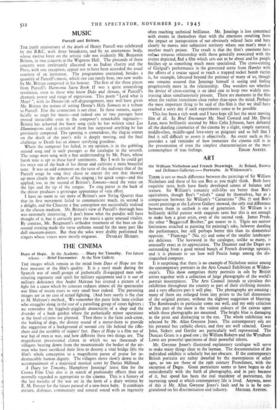ART
Sir William Nicholson and French Drawings. At Roland, Browse and Delbanco Galleries.—Portraits. At Wildenstein's.
THERE is not so much difference between the paintings-of Sir William Nicholson and those of his son Ben as you might think. Both have exquisite taste both have finely developed senses of balance and texture. Sir William's romantic still-lifes are better than Ben's equivalents, though Ben's " reliefs " stand by themselves, but as a comparison between Sir William's " Carnations " (No. 7) and Ben's recent paintings at the Lefevre Gallery showed, the only real difference between them in outlook is one of generation. Sir William is a brilliantly skilful painter with exquisite taste but this is not enough to make him a great artist, even of the second rank. James Pryde, the other " Beggarstaff Brother," got nearer to it. Tlrre are narrow limitations attached to painting for painting's sake, however dazzling the performance, but still perhaps better this than its diametrical opposite. " Flamingo " (No. 15) and some of the smaller landscapes are delicious. -The foreword in• the catalogue, unlike so many, is unusually exact in its appreciation. The Daumier and the Degas are outstanding from a good mixed bunch of French drawings upstairs, and it is pleasant to see how well Pascin hangs among the dis- tinguished company.
It is surprising that there is no example of Nicholson senior among the contemporary portraits in the Arts Council Exhibition at Wilden- stein's. This show comprises thirty portraits in oils by British artists together with a collection of large photographs of the world's portrait masterpieces. The Arts Council intends to circulate this exhibition throughout the country as part of their civilising mission, and a very effective part it will play. The photographs are amazing ; many of them are enlarged from tiny prints to the full dimensions of the- original picture, without the slightest suggestion of blurring. The Rembrandts in particular come out well, and my only criticism of this part of the show is the violent colours of the canvas upon which these photographs axe mounted. The bright blue is damaging to the print and distracting to the eye. The whole exhibition was selected by Mr. Allan Gwynne Jones. The contemporary oils are his personal but catholic choice, and they are well selected. Gwen John, Sickert and Gertkr are particularly well represented. The Duncan Grant is a good one ; the William Roberts and the Wyndham Lewis are powerful specimens of their powerful talents.
Mr. Gwynne Jones's illustrated explanatory catalogue will serve to make many things clear to the layman. The documentation of the individual exhibits is scholarly but not obscure. If the contemporary British portraits are rather dwarfed by the masterpieces of other ages, so too are those of the 19th century Frenchmen, with the exception of Degas. Great portraiture seems to have begun to die coincidentally with the birth of photography, and in part because of it, but speed has been the real murderer of portraiture, the increasing speed at which contemporary life is lived. Anyway, none of this is Mr. Allan Gwynne Jones's fault- and he is to be con- gratulated on his discrimination and industry. Mzoilum AurroN.






























 Previous page
Previous page